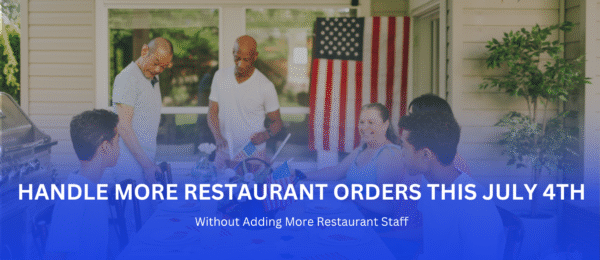VoicePlug’s conversational AI now integrated with Qu to enable intuitive voice ordering across phones and drive-thrus.Palo Alto, CA…
Learn More
Navigating the Evolving Restaurant Landscape
Solutions to the Top Challenges Faced by Independent Operators
The restaurant industry has undergone a seismic shift in recent years, leaving many independent and mid-size restaurant chain operators grappling with a myriad of challenges. From staffing shortages and soaring costs to the complexities of integrating technology, the path to success has become increasingly arduous. However, with the right strategies and a willingness to adapt, restaurant owners can not only overcome these obstacles but also position their businesses for long-term growth and prosperity.
In this comprehensive guide, we’ll delve into the top challenges facing independent restaurateurs and provide validated solutions to help you navigate the evolving landscape.
Key Challenges and Actionable Solutions:
1. Staffing and Labor Costs:
One of the recurring challenges faced by independent restaurant owners is the struggle with staffing. Labor costs, recruitment difficulties, and retaining skilled employees have become uphill battles.
Solution
- Offer competitive wages, benefits, and incentives to attract and retain quality staff.
- Invest in training and development programs to improve employee skills and morale.
- Explore automation and self-service technologies to reduce reliance on labor.
- Implement flexible scheduling and cross-training strategies to boost productivity.
2. Rising Costs:
Profitability is a constant concern for restaurant owners, and rising costs of goods, equipment, and rent only amplify these worries. Striking the right balance between competitive pricing and operational expenses requires strategic cost-management strategies.
Solution
- Negotiate better deals with suppliers and landlords to manage input costs.
- Implement inventory management systems to minimize waste and spoilage.
- Optimize menu pricing and offerings to maintain profit margins.
- Explore alternative sourcing strategies, such as local or direct-from-producer options.
3. Technology Integration Challenges:
The advent of technology has brought both opportunities and challenges for restaurant owners. The integration of Point-of-Sale systems with third-party delivery apps has become a necessity. However, this presents operational challenges, particularly for both small-scale and mid-size restaurant operators. Streamlining technology usage and exploring cost-effective solutions, such as POS systems that seamlessly connect with Voice AI ordering systems, and popular delivery platforms, ensure improved efficiency and customer satisfaction. Ideally, AI phone ordering systems, POS, Online Ordering Systems, and Loyalty systems must talk to each other smoothly.
Solution
- Invest in a robust, integrated POS system that can seamlessly connect with online ordering, delivery apps, and back-office functions.
- Work with expert Voice AI technology providers to customize solutions that automate the food ordering process through multiple channels such as Phone, Drive-Thru, and Kiosks.
- Leverage data analytics to gain insights into customer behavior and operational efficiencies.
4. Adapting Business Models:
Consumer preferences and market trends constantly evolve, and keeping up with these changes is essential for success. Being adaptable and responsive to customers’ needs and preferences is crucial. Additionally, the impact of social media on business visibility cannot be underestimated.
Solution
- Consider manageable, more flexible restaurant formats with lower overhead in the beginning.
- Diversify revenue streams, such as expanding into catering, meal kits, virtual kitchens, or ghost kitchens.
- Experiment with different service models, like counter service or hybrid dine-in/takeout.
5. Regulatory Compliance and Administrative Burdens
Steering through regulatory requirements, licensing fees, taxes, and insurance obligations contributes to the administrative load on restaurant owners. Compliance with health and safety regulations, employment laws, and food handling guidelines is vital for both legal and reputational reasons. Restaurant operators should seek methods to lessen the burden and mitigate potential risks.
Solution
- Stay informed on regulatory changes through industry associations and seek expert legal/financial advice.
- Leverage technology for payroll, HR, compliance, and inventory management to streamline admin tasks.
- Implement staff training and internal audits to maintain a culture of health, safety, and employment law compliance.
- Budget for licensing, taxes, and insurance; explore financing options for major compliance costs.
- Build positive relationships with regulators, stay on top of renewals, and engage proactively.
- Participate in industry associations for resources, advocacy support, and collective bargaining.
- Develop contingency plans and maintain appropriate insurance coverage for business continuity.
6. Enhancing Customer Experience:
While the restaurant industry has traditionally prided itself on hospitality and excellent service, a concerning trend of entitled and inconsiderate customer behavior has emerged in recent years. Patrons have become increasingly demanding, impatient, and, in some cases, outright disrespectful towards staff.
- Invest in staff training to improve customer service and conflict resolution skills.
- Implement clear policies and communication around expectations for customer behavior.
- Leverage online review management and social media platforms to address feedback and concerns.
Conclusion:
The restaurant industry is undergoing a transformative period, and independent operators who embrace innovative solutions and data-driven strategies will be well-positioned to thrive. By addressing the key challenges outlined in this guide and implementing the validated solutions, you can navigate the evolving landscape, optimize your operations, and deliver an exceptional dining experience that sets your business apart from the competition.
Remember, the road ahead may be challenging, but with the right mindset and a willingness to adapt, you can overcome these obstacles and emerge as a stronger, more resilient restaurant operator. Embrace the change, leverage technology, and prioritize your team and customers – the path to success is within reach.
The VOICEplug AI Advantage: Streamlining Orders and Boosting Efficiency
While integrating various technologies can be a challenge, VOICEplug AI simplifies the process. Our voice AI solution seamlessly integrates with your existing POS system, enabling hands-free ordering through phone calls, drive-thrus, or kiosks. This eliminates the need for clunky phone systems and manual order entry, reducing errors and streamlining operations.
Here’s how VOICEplug AI empowers your restaurant:
- Improved Accuracy: Say goodbye to order mistakes! VOICEplug AI understands natural language and reduces errors by taking orders directly from the customer’s voice.
- Enhanced Efficiency: Free up your staff to focus on other tasks by automating the ordering process. Faster order processing translates to shorter wait times and happier customers.
- Seamless Integration: VOICEplug AI integrates smoothly with your existing POS system, ensuring a cohesive and efficient workflow.
By implementing VOICEplug AI, you’ll not only address the challenge of technology integration but also gain a significant advantage in terms of order accuracy, staff efficiency, and customer satisfaction.
Articles you might like
Nearly 83% of consumers bought food to celebrate the 4th of July in 2024, based on a sentiment…
Learn More“We have more calls nowadays because people find it easier to place their orders. I think that’s the…
Learn More



